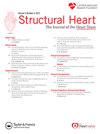经导管三尖瓣置换术后心动过缓的处理
IF 2.8
Q3 CARDIAC & CARDIOVASCULAR SYSTEMS
引用次数: 0
摘要
最近经导管三尖瓣的开发和批准代表了三尖瓣反流患者管理的重大突破,这些患者不适合现有的侵入性或介入治疗。尽管有良好的结果,起搏器依赖是经导管三尖瓣置换术(TTVR)的常见后果。在关键的TRISCEND II随机试验中,需要植入起搏器的传导障碍是30天最常见的主要不良事件。处理三尖瓣位置瓣膜植入后的心动过缓需要专门的知识和量身定制的临时和永久起搏方法。这种必要性是由阀门的特定设计特点和不断发展的阀门节余起搏策略所驱动的。我们的目的是总结这些独特的挑战,以支持心脏团队成员和非电生理保健专业人员执行TTVR,以及可能不熟悉TTVR独特特征的重症监护病房和心动过缓专家。由于房室(AV)传导延迟导致的心动过缓,需要植入新的起搏器,大约1 / 4的患者接受生物假体EVOQUE瓣膜,其他TTVR装置也很常见。这篇综述总结了目前关于TTVR相关的心动过缓的知识以及急性和长期设置的管理算法,强调了接受TTVR的患者的专门考虑。本文章由计算机程序翻译,如有差异,请以英文原文为准。
Managing Bradycardia in Patients After Transcatheter Tricuspid Valve Replacement
The recent development and approval of a transcatheter tricuspid valve represent a significant breakthrough in the management of patients with tricuspid regurgitation who are not suitable for existing invasive or interventional therapies. Despite promising outcomes, pacemaker dependency is a common consequence of transcatheter tricuspid valve replacement (TTVR). In the pivotal TRISCEND II randomized trial, conduction disorders requiring pacemaker implantation were the most frequent major adverse event at 30 days. Managing bradycardia following valve implantation in the tricuspid position requires specialized knowledge and tailored approaches for both temporary and permanent pacing. This necessity is driven by the specific design features of the valves and the evolving choices of valve-sparing pacing strategies. Our aim is to summarize these unique challenges to support both heart team members and nonelectrophysiology health care professionals performing TTVR, as well as intensive care unit and bradycardia specialists who may be unfamiliar with the distinctive characteristics of TTVR. Bradycardia due to atrioventricular (AV) conduction delay, requiring new pacemaker implantation, affects approximately 1 in 4 patients receiving the bioprosthetic EVOQUE valve and is also common with other TTVR devices. This review summarizes current knowledge on TTVR-associated bradycardia and a management algorithm for both acute and long-term settings, highlighting specialized considerations for patients undergoing TTVR.
求助全文
通过发布文献求助,成功后即可免费获取论文全文。
去求助
来源期刊

Structural Heart
Medicine-Cardiology and Cardiovascular Medicine
CiteScore
1.60
自引率
0.00%
发文量
81
 求助内容:
求助内容: 应助结果提醒方式:
应助结果提醒方式:


